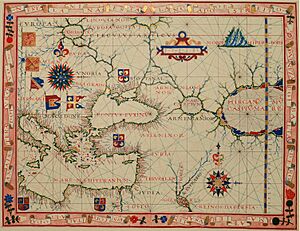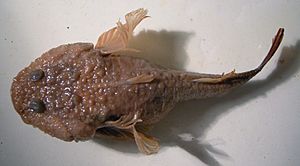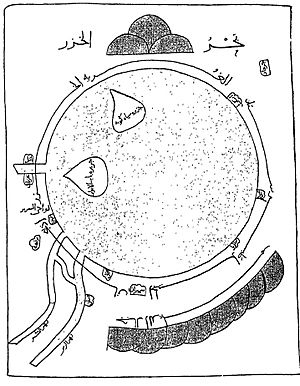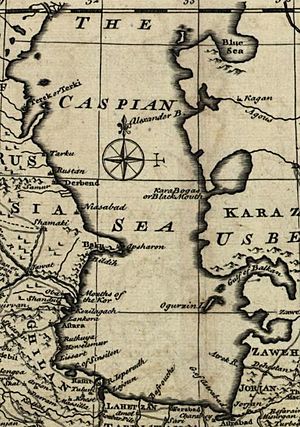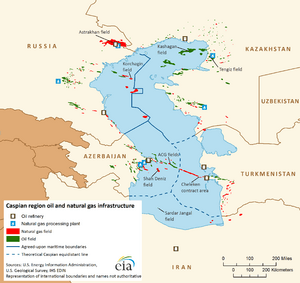Caspian Sea facts for kids
Quick facts for kids Caspian Sea |
|
|---|---|
| Xəzər dənizi / دریای کاسپین / Каспий теңізі / Каспийское море / Hazar deňzi | |
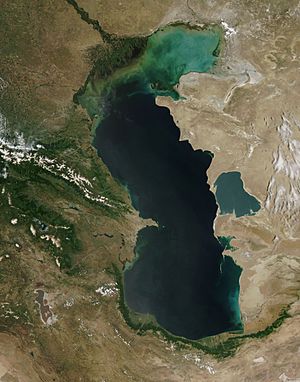
The Caspian Sea as captured by the MODIS on the orbiting Terra satellite, June 2003
|
|
| Coordinates | 41°40′N 50°40′E / 41.667°N 50.667°E |
| Type | Endorheic, Saline, Permanent, Natural |
| Primary inflows | Volga River, Ural River, Kura River, Terek River |
| Primary outflows | Evaporation, Garabogazköl |
| Catchment area | 3,626,000 km2 (1,400,000 sq mi) |
| Basin countries | Azerbaijan, Iran, Kazakhstan, Russia, Turkmenistan |
| Max. length | 1,030 km (640 mi) |
| Max. width | 435 km (270 mi) |
| Surface area | 371,000 km2 (143,200 sq mi) |
| Average depth | 211 m (690 ft) |
| Max. depth | 1,025 m (3,360 ft) |
| Water volume | 78,200 km3 (18,800 cu mi) |
| Residence time | 250 years |
| Shore length1 | 7,000 km (4,300 mi) |
| Surface elevation | −28 m (−92 ft) |
| Islands | 26+ |
| Settlements | Baku (Azerbaijan), Anzali (Iran), Aktau (Kazakhstan), Makhachkala (Russia), Türkmenbaşy (Turkmenistan) (see article) |
| 1 Shore length is not a well-defined measure. | |
The Caspian Sea is the biggest inland body of water on Earth. It's so large that people sometimes call it the world's largest lake, and sometimes a full sea! It's located between the continents of Europe and Asia.
It's surrounded by five countries: Kazakhstan (to the northeast), Russia (northwest), Azerbaijan (west), Iran (south), and Turkmenistan (southeast). The Caspian Sea is in an endorheic basin, which means water flows into it, but there's no natural way for water to flow out to an ocean.
The Caspian Sea is about 28 m (92 ft) below sea level. This makes it one of the lowest natural places on Earth. Long ago, people living near its shores thought it was an ocean because of its huge size and salty water.
The sea covers an area of about 371,000 km2 (143,200 sq mi). Its water volume is about 78,200 km3 (18,800 cu mi). The water is salty, but not as salty as the ocean. It has about one-third the saltiness of most seawater.
Contents
What is the Caspian Sea like?
How did the Caspian Sea form?
The Caspian Sea is a leftover part of an ancient ocean called the Paratethys Sea. About 5.5 million years ago, land movements and falling sea levels trapped this part of the ocean. It became a landlocked basin.
During very warm and dry times, the sea almost dried up. It left behind salty sediments. When cooler, wetter times came, the basin filled up again. Today, the northern part of the Caspian Sea is less salty because many rivers flow into it. The southern part, near Iran, is saltier.
Where is the Caspian Sea located?
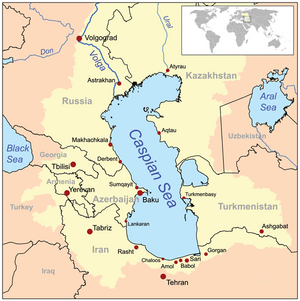
The Caspian Sea is the largest inland body of water in the world. It holds about 40% to 44% of all the lake water on Earth. Its coastlines are shared by Azerbaijan, Iran, Kazakhstan, Russia, and Turkmenistan.
The Caspian Sea has three main parts: the Northern, Middle, and Southern Caspian.
- The Northern Caspian is very shallow, only about 5–6 metres (16–20 ft) deep on average. It holds less than 1% of the sea's total water.
- The Middle Caspian is deeper, with an average depth of 190 metres (620 ft).
- The Southern Caspian is the deepest part. It reaches depths of over 1,000 metres (3,300 ft). This part holds about 66% of the sea's total water.
In winter, the northern part of the Caspian Sea usually freezes. In very cold winters, ice can form in the south too.
More than 130 rivers flow into the Caspian Sea. The Volga River is the largest, bringing in most of the water. Other important rivers include the Ural River and the Kura River. The Caspian Sea also has many small islands, mostly in the north.
The land around the Caspian Sea changes a lot. To the northeast, there are dry steppes. To the west, you'll find the Caucasus Mountains. The climate varies greatly, leading to a wide variety of plants and animals.
How does the water level change?
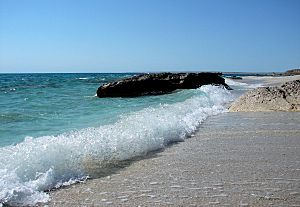
The Caspian Sea acts like both a sea and a lake. It's often called the world's largest lake, even though its water is salty. It holds about 3.5 times more water than all five of North America's Great Lakes combined.
The Caspian Sea was once part of a huge ocean. But about 5.5 million years ago, land movements made it landlocked. The Volga River provides about 80% of the water flowing into the Caspian Sea. However, there's no natural way for water to flow out, except through evaporation.
The water level of the Caspian Sea has changed a lot over hundreds of years. It has risen and fallen quickly many times. These changes are often linked to how much rain falls in the Volga River's basin. This rainfall is affected by weather patterns far away in the North Atlantic.
For example, from 1929 to 1977, the sea level fell by 3 m (10 ft). Then, from 1977 to 1995, it rose by 3 m (10 ft). Since then, there have been smaller ups and downs.
Is the Caspian Sea healthy?
The Volga River is Europe's largest river. It brings 80% of the water into the Caspian Sea. But the lower parts of the river have many factories and cities. These release chemical and biological pollution into the river. This pollution then flows into the Caspian Sea.
Oil and gas drilling and transport in the Caspian Sea also create risks for the environment. For example, the island of Vulf near Baku has been harmed by the petrochemical industry. This has caused a big drop in the number of sea birds there. New oil and gas pipelines under the sea could also threaten the environment.
In 2005, a large oil field called Vladimir Filanovsky was found in the Russian part of the sea. It was the biggest oil discovery there in 25 years. Oil production started in this area in 2016.
Animals and plants of the Caspian Sea
Plants
The changing water level of the Caspian Sea can harm rare water plants. When the water level rises, it reduces the places where these plants can grow. This is because there aren't enough seeds in the new shallow areas.
Some special plants, like the waterwheel plant and the native Caspian lotus, are found in the Volga delta. The sandy shores also provide a home for plants that can live in desert conditions.
Animals
The Caspian turtle lives in nearby areas but is a freshwater animal. The zebra mussel comes from the Caspian and Black Sea areas. But it has become an invasive species in other parts of the world.
The Caspian seal is the only aquatic mammal that lives only in the Caspian Sea. It's one of the few seal species that live in inland waters.
Long ago, there might have been dolphins, porpoises, or even large whales in the Caspian Sea. Ancient rock carvings suggest this. However, today, these large marine mammals are not found there.
The Caspian Sea basin is home to 160 different kinds of fish. About 62% of these fish species are endemic, meaning they are found nowhere else. The most common fish families are gobies, cyprinids, and clupeids.
Six types of sturgeon fish live in the Caspian Sea: the Russian, bastard, Persian, sterlet, starry, and beluga sturgeon. The beluga sturgeon is thought to be the largest freshwater fish in the world. Sturgeon are famous for their eggs, called caviar.
However, too much fishing has greatly reduced the number of sturgeon. Environmental groups want to ban sturgeon fishing completely to help the population recover. The high price of caviar makes it hard to stop illegal fishing.
History of the Caspian Sea region

The oldest human remains found near the Caspian Sea are about 1.8 million years old. They belong to early humans like Homo erectus. Later evidence of human life comes from caves in Georgia and Azerbaijan.
People have lived in the area south of the Caspian Sea for at least 11,000 years. This is known from discoveries in caves in Iran.
The Caspian region has been rich in energy resources for a long time. People were digging for oil as early as the 10th century. They used oil for medicine, heating, and lighting. By the 16th century, Europeans knew about the large oil and gas deposits. English traders described oil flowing from the ground near Baku.
In the 18th century, Fedor I. Soimonov explored and mapped the Caspian Sea. He created the first modern maps and reports of the sea, published in 1720. Today, many oil and gas platforms can be seen along the sea's edges.
Oil extraction in the Caspian Sea
The world's first offshore oil wells were drilled in Bibi-Heybat Bay, near Baku, Azerbaijan. In 1873, oil exploration began in some of the largest oil fields known at that time. These fields were on the Absheron peninsula.
By 1900, Baku had over 3,000 oil wells. Many skilled workers came to the city, and Baku became known as the "black gold capital."
In 1920, when the Bolsheviks took control of Azerbaijan, all private oil properties were taken over by the Soviet Union. By 1941, Azerbaijan was producing a record 23.5 million tons of oil. The Baku region supplied almost 72% of all oil in the Soviet Union.
In 1994, a very important agreement called the "Contract of the Century" was signed. This started major international efforts to develop the Baku oil fields. A large pipeline, the Baku–Tbilisi–Ceyhan pipeline, opened in 2006. This pipeline allows oil from Azerbaijan to flow directly to the Turkish port of Ceyhan on the Mediterranean Sea.
Images for kids
-
Illustration of two Caspian tigers, extinct in the region since the 1970s.
-
A New and Accurate Map of the Caspian Sea by the Soskam Sabbus & Emanuel Bowen, 1747.
-
Baku, the capital of Azerbaijan is the largest city by the Caspian Sea.
-
Makhachkala, the capital of the Russian republic of Dagestan, is the third-largest city on the Caspian Sea.
-
Drilling platform "Iran Khazar" in use at a Dragon Oil production platform in the Cheleken field (Turkmenistan).
See also
 In Spanish: Mar Caspio para niños
In Spanish: Mar Caspio para niños


